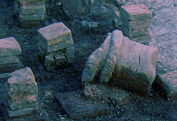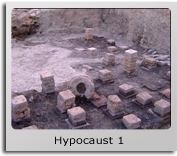
|
 |
||

|
Post-Excavation Ian Miller and his team are now feverishly working on post-excavation work to conserve and evaluate all the finds. This will eventually culminate in a special publication, funded by the developers, Modus, which will tell the full story based on the project's discoveries. Further information has already emerged, such as the previously mentioned last firing of the stoke holes and lately, the identification of flue tiles amongst the quantities of building materials. These hollow tiles, designed to channel the hot gases from the under-floor heating up through the walls, would have been embedded in the inside walls of the hypocaust rooms making sure the whole structure was kept warm. More significantly, fragments of 'voussior' have been also identified. These were special box flues which were shaped into arch sections such that, when put together, would form the barrel-vaulted roofs so typical of Roman bathhouses. They were light and hollow enabling the hot gasses to continue from the walls, through the vaulted roof and out at the top through small chimneys. Finally, arrangements are currently being planned for a reconstruction of the hypocaust to be displayed in the Grand Arcade development using as much of the original material as possible - a fine tribute to Wigan's Roman heritage. Bill Aldridge Wigan Archaeological Society Gallery >> |
||